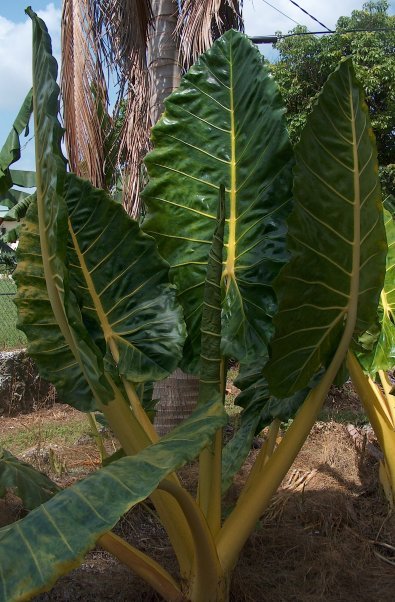





Some plants are like icons in gardens, and when crafting a tropical garden, one of the most important icons is the group of big leaved plants known by some as "Elephant Ears", or "EEs". Among these, the large terrestrial Alocasias hold the position of prominence - read on for an introduction to these behemoths of tropical splendor . . .
If your growing area is very limited, the Jewel Alocasias will fit right in. However, if you have land to fill and a penchant for the exotic and tropical look, you'll need to seek out the much larger cousins of the Jewels, the terrestrial Alocasias. I state "terrestrial" because while many of the Jewels are found on rocks or in situations where soil is relatively sparse. these "Big Ears" thrive best in regular soil situations. As such, these are not stressed by moist soil around the roots, or frequent watering such as is found in rain forests.
In my experience, these large-leaved plants divide into three major groupings: the odora group, the macrorrhizos group, and the sarawakensis group. Each of these has particular distinguishing characteristics that, in my view, set them apart as distinct. The odora group, of which A. odora is the type specimen, is characterized by plants with a closed leaf sinus on mature leaves and powdery bluish-colored inflorescences with a matte look and a mildly fruity odor. The sinus is the area where the petiole attaches to the leaf blade. Those in the macrorrhizos group, of which A. macrorrhizos is the type specimen, have an open sinus on the mature leaf and have inflorescences that are not at all powdery looking. These inflorescences are on the shiny green side, with a somewhat unpleasant non-fruity scent. Finally, the sarawakensis group, of which A. sarawakensis is the type specimen, have light to white inflorescences with a pungent, non-fruity odor. Species in the sarawakensis group may have prominent veination and even very fine pubescence on the petioles and leaf undersides.
Just for fun, I've included here a photo of a real "elephant ear" (see photo below) so once and for all everyone can see what, if any, the resemblance is between the real thing and these "Big Ear" Alocasias.

Most of the large Alocasias seen in tropical gardens are of either the odora group or the macrorrhizos group. While the macrorrhizos group has the most diversity of form by far when compared to the other two groups, members of the odora group exhibit the greatest cold-hardiness. The sarawakensis group is relatively new to the horticultural scene so few species or cultivars are yet available.
One other group that does not fit in with any of these three is the Xenophya group. Those plants grouped here were once considered to be in a separate genus, Xenophya. An example of a plant in this group is Alocasia lauterbachiana. These do not grow nearly as large as plants in each of the other three groups, and are characterized by their relatively peculiar inflorescences and by how close the sheathing part of the petioles is to the sinus area of each leaf.
By and large, the one characteristic the "Big Ears" have in common is the size of their leaves, or "ears". In addition to this, a few offer some coloration or variegation in addition to the default green. In the macrorrhizos types, in particular, can be seen dark purple petioles, reddish and mottled petioles, and bright yellow petioles (see photo below).  The leaf blades are not normally colored except in the case of the yellow or white variegates, and those very few with purplish undersides to the leaves.
The leaf blades are not normally colored except in the case of the yellow or white variegates, and those very few with purplish undersides to the leaves.
My years of working with these plants has shown me that when crossing within a group, the progeny are usually fertile, but when crossing between groups, the progeny are likely to be sterile or nearly so. One of my hybrids, which is a well-known "ear" in tropical gardens, is Alocasia x portora, often incorrectly called "portodora" or "portidora". This plant is a cross between plants in two different groups, A. odora, of the odora group, and A. portei, of the macrorrhizos group. Predictably, the progeny, while very vigorous and desirable for tropical effect, are essentially sterile sexually. By contrast, another cross I did, using two plants in the macrorrhizos group, yielded a hybrid with abundant fertile pollen. Some Alocasias surprised me when I discovered that several plants designated as "species" turned out to be sterile sexually.
In upcoming articles I will be spotlighting various large Alocasias and discussing the merits of each with regard to their use in the tropical garden.
Photo credit: publicdomainpictures.net/ and LariAnn Garner
Copyright © www.100flowers.win Botanic Garden All Rights Reserved